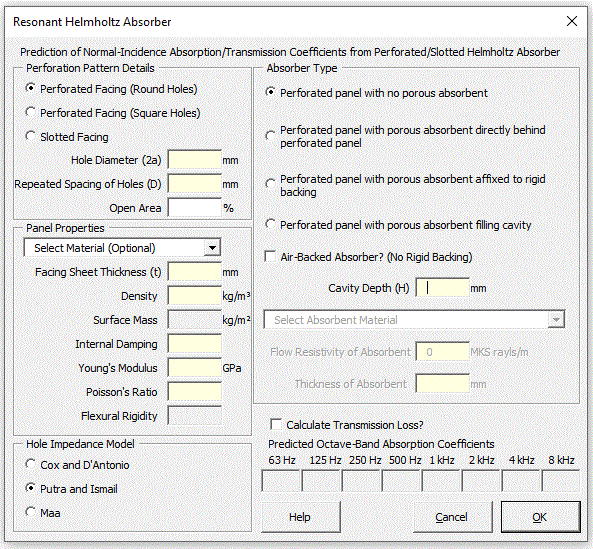Figure 1

Strutt|Building Acoustics|Resonant (Helmholtz) Absorber calculates the normal-incidence absorption coefficients or transmission loss of a resonant Helmholtz-type absorber implemented as a perforated or slotted sheet over an air gap, and inserts the calculated values into the active row of the worksheet.
Strutt calculates for the following absorber geometries:

Strutt calculates the normal-incidence absorption coefficients `alpha` from the complex pressure-reflection factor `R` between the surface of the absorber and the air using the following formula:
`R = (Z_S-Z_0)/(Z_S+Z_0)`
`alpha = 1-|R|^2`
where:
`Z_0` is the characteristic impedance (`rho C`) of air
`Z_S` is the surface impedance of the absorber
With a partitioned-cavity (e.g. a 'honeycomb' type structure behind the perforated panel), the oblique-incidence absorption coefficients will be essentially the same as for normal-incidence. Oblique-incidence coefficients for non-partitioned cavities may be added in a future release.
Strutt calculates the normal-incidence transmission loss using the complex pressure-transmission factor `T` of the construction and the power transmission coefficient `tau` using the following formulae:
`T = (2Z_S)/(Z_S+Z_0)`
`tau = |T|^2`
`"TL" = 10log_"10"(tau)`
The surface impedance of the resonant absorber is calculated using:
`Z_S = Z_R + Z_(n-1)`
where:
`Z_R` is the effective impedance of the perforated facing
`Z_(n-1)` is the impedance of the layer of the absorber immediately under the perforated sheet (either air or a porous material).
The facing impedance is calculated using the specific hole impedance `z_h` and (optionally) the mechanical impedance of the perforated plate `z_p` as follows:
Where the mechanical properties of the panel are entered, the perforated sheet impedance is the effective impedance (in parallel) of the hole impedance and the mechanical impedance:
`Z_R = z_h/(1 + gamma zeta z_h/z_q)`
`z_q` is a modified plate impedance; `z_q = z_p + (Re(Z_h)Im(Z_h))/z_h`
`gamma = 1 - (Im(Z_h))/z_h` is a complex non-dimensional term
`zeta = 1 - epsilon + (Re(Z_h))/z_h` is a complex non-dimensional term
If the hole size is zero (i.e. unperforated sheet), the facing impedance is calculated using only the mechanical impedance of the plate `z_p`:
`Z_R = z_p`
If the mechanical properties of the sheet are not entered, the facing impedance is calculated using only the specific hole impedance `z_h`:
`Z_R = z_h`
The hole impedance `Z_h` is calculated using one of three user-selected theoretical models:
The specific hole impedance `z_h` is obtained from the hole impedance `Z_h` and the perforation ratio `epsilon`:
`z_h = Z_h/epsilon`
The in vacuo mechanical impedance `z_p` of the plate is calculated as follows:
`z_p = j omega m(1 - (j mu omega_n)/omega)-(js)/omega`
`m` is the panel surface mass (kg/m2)
`s` is the panel stiffness. Strutt calculates the stiffness from the mechanical properties of the panel material using a first-order approximation for the flexural rigidity of a plate
`s = (E t^3)/(12(1-upsilon^2))`
`E` is the Young's Modulus of the material
`upsilon` is the Poisson's ratio of the material
`t` is the plate thickness
The mechanical properties of the plate are by default taken from the materials database used in the Transmission Loss Prediction calculation, but may be modified by the user.
In reality, the edge strutt properties of the absorber will also affect the stiffness (and are not taken into account in the approximate form of the panel stiffness calculation); accordingly use the results of the absorption prediction with caution where the panel absorption component from the plate is predicted to be significant compared to the Helmholtz component.
`mu` is the mechanical loss factor
`omega_n = sqrt(s/m)` is the undamped natural frequency of the panel
`epsilon` is the fractional open area of the perforated sheet
`a` is the hole radius of perforations (circular perforated sheet), hole dimension (square perforated sheet) or slot width (slotted sheet)
`d` is the repeated spacing of the perforations/slots
`t` is the thickness of the covering sheet
`rho_0` is the density of air (1.21 kg/m3)
`eta` is the viscosity of air (18.4x10-6 Ns/m2)
`nu` is the kinematic viscosity of air (15x10-6 m2/s)
`delta` is an end-correction factor for flow through the slots/perforations:
`omega` is the angular frequency (`2 pi f`)
`j` is the square root of -1.
The surface impedance of one layer of the absorber (`Z_(Si+1)`) is related to the surface impedance of the layer below it (`Z_(Si)`) using:
`Z_(Si+1) = (-j Z_(Si) Z_i cot(k_(x i) d_i) + Z_i^2)/(Z_(Si) - j Z_i cot(k_(x i) d_i))`
where:
`d_i` is the thickness of the layer
`Z_i` is the characteristic impedance of the layer
`k_(x i)` is the wavenumber for normal-incidence sound propagation in the layer
The surface impedance of the bottom layer of the absorber is found using the above formula, but imposing either:
For air, `Z_i = Z_0` and `k_(x i) = k_0 = omega//c`
For porous absorbent, `Z_i` and `k_(x i)` are calculated using the Delaney and Bazley formulation:
`Z_i = rho_0 c_0 (1 + 0.0571X^(-0.754) - j 0.087X^(-0.732))`
`k = k_0 (1 + 0.0978X^(-0.7)-j0.189X^(-0.595))`
where `X` is a frequency-dependent parameter given by:
`X = (rho_0 f)/sigma`
`sigma` is the flow resistivity (MKS rayls/m) of the porous absorbent.
A drop-down menu is provided giving flow-resistivity values for several common absorbent materials, or else the user may enter in the flow resistivity manually.Strutt calculates the octave-band absorption coefficient as the aritmetic average of 50 geometrically-spaced points within each octave-band. A sensitivity study was conducted and 50 sample points in each octave were found to give an acceptable value for the octave-band absorption coefficient, being within 4 significant figures of the value produced by taking 1000 samples in each octave band.
References: